A Battle Cry — It's Technology against Diabetes
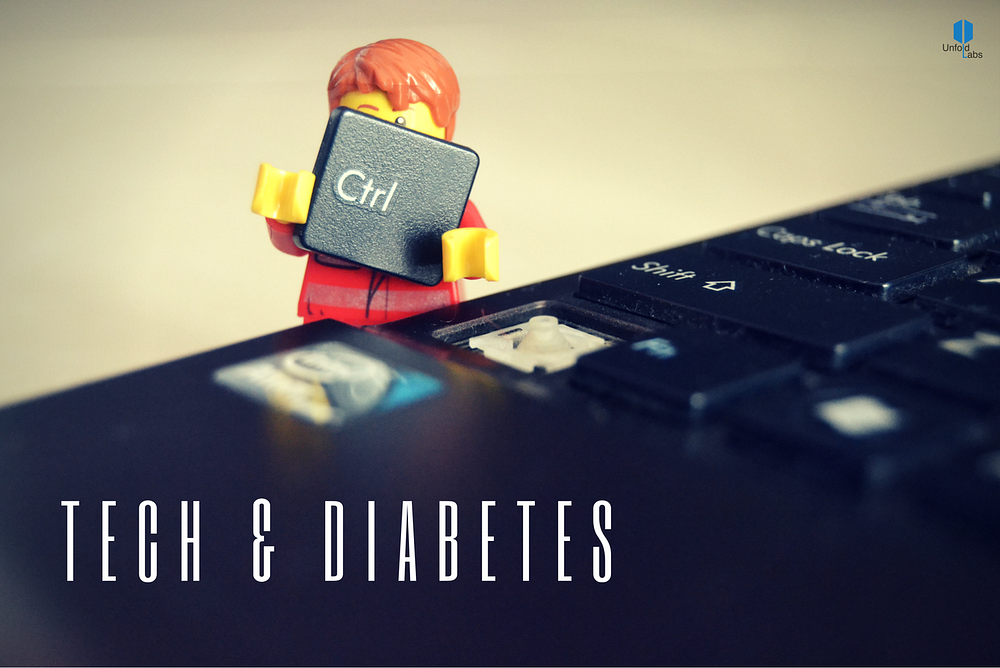
Diabetes, a metabolic disease leading to life threatening complications, affects millions of people across the globe. Life Sciences & Technology, two powerful arms of science are now working together to combat diabetes and its effects on mankind.
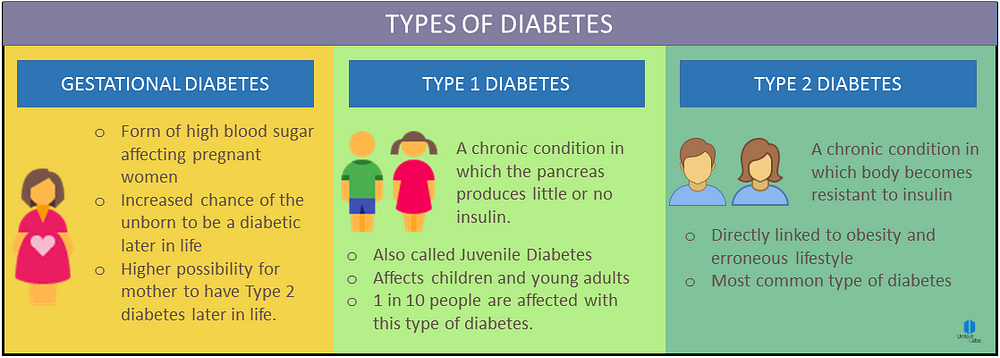
The Growing Menace of Diabetes

Solution 1 — Combat Diabetes through Genetics & Technology
Genetics — a systematic, well organized study of genes to predict and foresee outliers and trouble makers, is now becoming increasingly dependent on Information Technology as a tool that can help combat life threatening diseases like diabetes by predicting preventive measures and alternative cures.
Two major areas of Genetics are being researched as a solution to Diabetes:
- Genetic Engineering — that deals with deliberate modifications of faulty genes. This relies on intelligent software for sequencing and cloning to unravel the logic in the patterns of the human genetic makeup. This also guides scientists/researchers to arrive at logical conclusions by making it easy and methodical for genome editing and gene therapies for corrective actions in diseases like diabetes.
- Bioinformatics — that uses computers & information technology to research/analyse life functions better. This area does biological computations in tandem with genetic engineering, devises algorithms and designs of devices using software systems to arrive at synthetic biology to be programmed to work inside living cells.
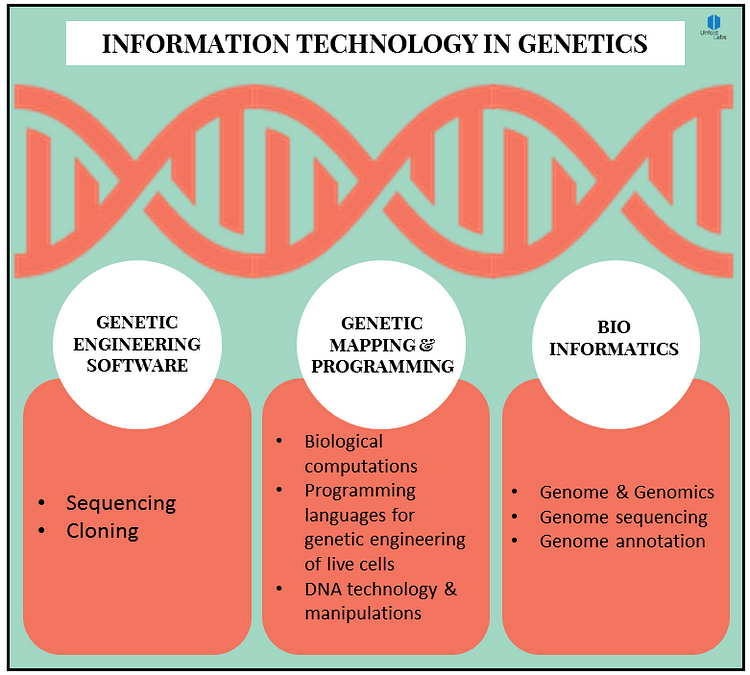
Various aspects of technology are being put to use for research in genetics. Contemporary techniques (like Big Data & Analytics, Mobile Technologies, Wearables, Internet of Things & Cloud) and Programming techniques are being used in sync with each other for a two pronged attack on diabetes.
Here are some interesting/cool areas that are being implemented/researched today.
- As an application of Machine Intelligence, Data Sciences and Research Communities are collaborating to make medical devices & pharmaceutical aids smarter/intelligent in an attempt to combat health problems.
- Less discussed pioneers from the IT fraternity like Microsoft are developing programming languages for genetic engineering of live cells.
- MIT's biological engineers have developed a unique programming language to design DNA encoded circuits to alter and infuse new functions into living cells, including corrective actions to treat diseases like diabetes by generating new DNA sequences.
- Computer Simulation Software is also emerging as a robust approach to scientific learning, with an aim to design systems and solutions for diabetes research and management with increased accuracy, reduced costs and efficient time spans for real-time functioning.
Solution 2 — Diabetes Management Powered by Technology
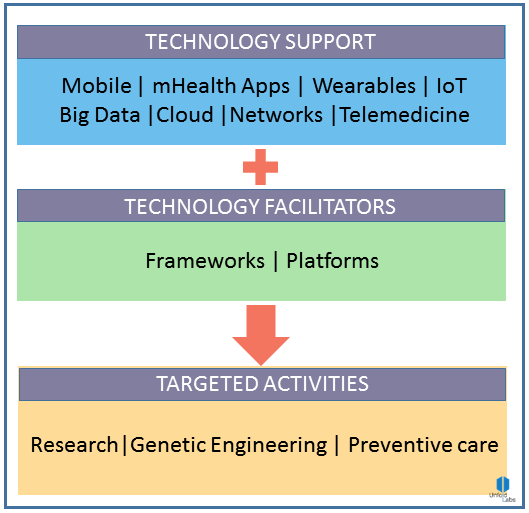
Advances in technology make it possible to provide flexible, practical and real-time self-management tools for diabetes. With innovations in mobile & wearables, data capture has become more effective and feasible for monitoring diabetes. This data being shared with storage and services in the data cloud helps diabetics with fast and timely solutions from caretakers.
Devices with companion apps, frameworks and/or platforms like mHealth and telemedicine are expected to bring a radical change to the methodologies used in combating diabetes. With the advent of easily usable mobile apps/devices, consumers can receive automatic messages and educational information about blood glucose values and self-manage their diabetes through apps and portals. This makes self-care easy as Mobile devices can now put health in the hands of the patients.
Intuitive Devices & Systems for Diabetes
A new trend called collaborative care adopts technologies for continuous monitoring of blood sugar levels and regulating appropriate insulin doses. Devices powered with these new approaches can be expected to be much more reliable as compared to the traditional clinical practices of recording with pen & paper or pricking.
Bio-engineering is working on designs for life sustaining systems to integrate with and support biological functions such as drug delivery into cells using software powered nano-systems like implantables and micro sensors.
Constant Glucose Monitoring — CGM
The FDA approved CGM devices are the most trusted and comfortable way to continuously monitor glucose levels in real-time. A small glucose sensor is placed under the skin and connected to a wireless transmitter, which relays data to a mobile device to display appropriate messages and colorful alerts. It not only helps alert care takers, but combined with proper Analytics tools, can generate patterns, trends and help provide guidelines to avoid catastrophic conditions.
Companion apps provide guidelines about critical parameters for care such as:
- Recommended Insulin doses
- Less discussed pioneers from the IT fraternity like Microsoft are developing programming languages for genetic engineering of live cells.
- Exercise plans
- Diet plans
- Any corrections and alterations in medicine, exercise and diet
Automatic Insulin Pumps & Pens
An insulin delivery system/pump that is the size of a mobile phone can be carried discreetly. It mimics the functions of healthy pancreas and releases the required amount of insulin under the skin. It can be programmed to suit the requirements of each wearer and the insulin doses are regulated and decided through quick algorithms. This completely avoids the need to measure insulin into syringes or prick the finger. The algorithms are separated into three parts:
- Basal rates
- Bolus doses to cover carbohydrate in meals
- Correction or supplemental doses
Artificial Pancreas
Artificial Pancreas could be a closed loop system comprising of the well-known CGM, sensor controlling programs and insulin delivery systems or automatic control of the blood glucose levels by substituting the endocrine functionality of a normal pancreas. In this new approach, the Artificial Pancreas has a sheet of encapsulated cells when surgically implanted would mimic the pancreas and can be used for many years.
Smart Lenses for Glucose Monitoring
Google is the pioneer in the smart lenses segment. Google Lenses has many applications like vision correction and augmented reality. It can also be used as a continuous glucose monitoring device — continuously recording data by its sensor, transmitting chip, antenna and companion software.
Samsung also has intentions of competing in this market and has announced its patent for smart contact lenses.
In-Car Diabetes Management Systems
Car crashes and collisions have a higher rate of occurrence among diabetics as varying glucose levels due to hypoglycemia or hyperglycemia lead to clumsiness, confusion and reduced levels of comprehension.
Ford has partnered with Medtronic for a Bluetooth-supported glucose monitor that can be networked in the automobile to keep the driver alert about his glucose levels and any chance of blackout due to change in glucose levels.
Frameworks & Platforms
The purpose of niche frameworks and platforms is to facilitate methodical and systematic data collection for accurate research. This helps evaluate history and genetics to arrive at logical predictions for preventive and corrective actions. These frameworks prompt pharmaceutical research to arrive at newer medicines and therapies for diabetes and have to abide at all times to the norms set out for privacy of data like HIPPA & cybersecurity. Interesting projects like Apple ResearchKit have always been at the center of discussion for technology in life sciences.
Challenges in Tech Vs Diabetes Solutions
Though data is collected for bringing solutions to diabetes, there is a huge fragmentation in the industry on how data is collected, shared and collated. This will cause problems in research and device innovations.
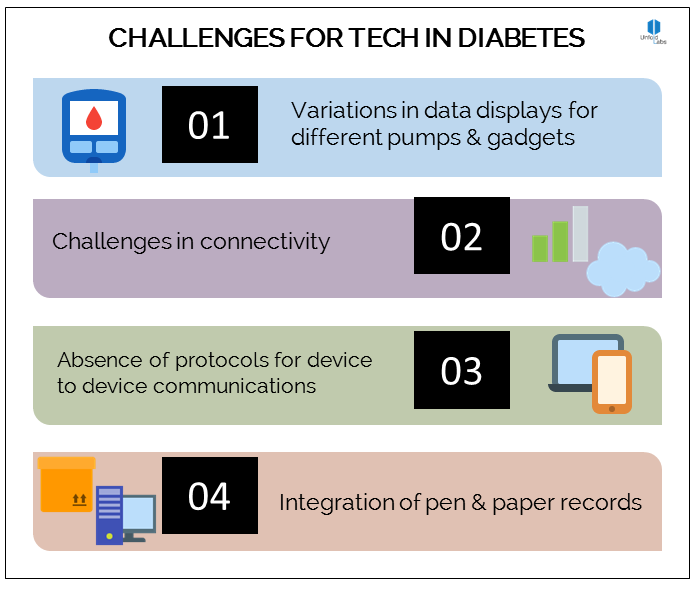
Our Take
Technology is everywhere; data omnipresent, flowing out from the sensors, quietly analyzed and streamed to the appropriate locations. With technological advances happening in the healthcare industry, big data becoming a bigger force of the future and with larger investments happening in healthcare, a stronger force to combat diabetes is on the way.
We predict that diabetes, almost an epidemic today may meet its match and will be curtailed if not eradicated by 2035. We will have short term solutions to diabetes by 2025, and by 2035 we would have found a way for us to get rid of diabetes with the help of technology.
. . .

